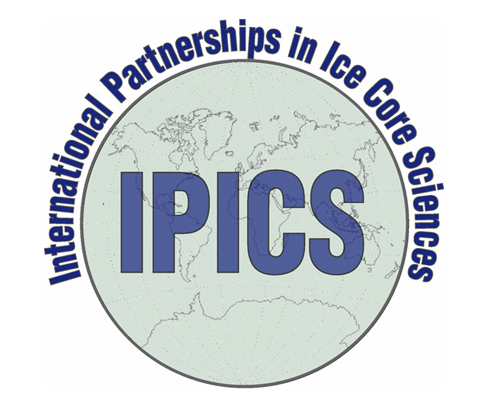International Partnerships in Ice Core Sciences (IPICS) has been an active organization since 2002, with a mission of defining and promoting priorities for international ice core science. Membership in IPICS is open to all countries conducting ice-coring activities, with 22 nations currently involved. Two co-Chairs manage IPICS, Eric Wolff (University of Cambridge) and Ed Brook (Oregon State University). The co-Chairs work with a steering committee, which has representatives from all IPICS nations as well as additional representatives for specific scientific issues.
One of the primary activities of IPICS is to create broad frameworks for ice coring activities in support of major international science goals. Originally, IPICS was organized around four scientific themes: 1) Creating an array of 2,000 year long ice core records to aid understanding of modern climate, 2) Creating an array of 40,000 year records to aid understanding of glacial-interglacial environmental change, 3) recovery of an Eemian climate record from Greenland, 4) The search for the "oldest ice core" – a 1.5 million year record from Antarctica, and 5) development of new technology for ice core drilling.
Over the last 5 years the IPICS themes have evolved somewhat, although the underlying scientific motivations remain very compelling. The 2,000 and 40,000-year array projects are well underway, with many new records and new efforts at synthesis of the data. The NEEM ice core in Greenland has recovered an Eemian record, albeit not in stratigraphic order, and a new, broader initiative on ice coring to study interglacials in general is emerging. The search for 1.5 million year old ice remains a cornerstone of IPICS efforts, and a new initiative on drilling to study ice dynamics is also developing.

IPICS has also been active in supporting and organizing conferences related to ice coring. Most notable among these was the 2012 IPICS Open Science Conference in Presqu'île de Giens, France, which brought together over 200 ice core scientists for a week of presentations and discussions. Smaller meetings organized by IPICS have focused on more specific topics, for example the 2012 Oldest Ice Meeting in La Londe les Maures. These focused meetings are intended to help move IPICS priority projects forward. In the case of the oldest ice project the La Londe les Maures meeting resulted in an influential paper in Climate of the Past (Fischer et al., 2013) which outlined our current understanding of the challenges of searching for oldest ice, and outlined remote sensing and modeling work needed to move the effort forward. Other IPICS-related synthesis efforts of note include contributions to the PAGES 2K networks and the recent PAGES 2K synthesis (Pages 2k Consortium, 2013), as well as independent synthesis of longer Antarctic records by Pedro et al. (2011) and Parrenin et al. (2013).
The first IPICS OSC stimulated the creation of a new organization, the Ice Core Young Scientists (ICYS). [See related article – Young Ice Core Scientists' Network.] ICYS now holds its own activities and more information can be found on their web site: http://www.pages-igbp.org/ini/end-aff/icys/overview.
IPICS is currently planning a second open science conference, for 2016. The host location has not been chosen yet, but should be known soon. The first OSC was extremely successful, and we fully expect the second to be similarly stimulating.
IPICS is an independent organization, but receives operating support from PAGES, SCAR, and IACS. Past IPICS meetings have been supported by those organizations and also by the US NSF, ESF, the EPICA Descartes Prize, and numerous other organizations. IPICS Web pages are maintained by PAGES at http://pastglobalchanges.org/ini/end-aff/ipics/intro.
References:
Fischer, H., Severinghaus, J., Brook, E., Wolff, E., Albert, M., Alemany, O., Arthern, R., Bentley, C., Blankenship, D., Chappellaz, J., Creyts, T., Dahl-Jensen, D., Dinn, M., Frezzotti, M., Fujita, S., Gallee, H., Hindmarsh, R., Hudspeth, D., Jugie, G., Kawamura, K., Lipenkov, V., Miller, H., Mulvaney, R., Parrenin, F., Pattyn, F., Ritz, C., Schwander, J., Steinhage, D., van Ommen,T., and Wilhelms, F. 2013. Where to find 1.5 million yr old ice for the IPICS "Oldest-Ice" ice core. Climate of the Past, 9(6), 2489-2505, doi:10.5194/cp-9-2489-2013.
PAGES 2k Consortium. 2013. Continental-scale temperature variability during the past two millennia. Nature Geoscience, 6, 339-346, doi:10.1038/ngeo1797.
Parrenin, F., Masson-Delmotte, V., Köhler, P., Raynaud, D., Paillard, D., Schwander, J., Barbante, C., Landais, A., Wegener, A., and Jouzel, J. 2013. Synchronous change of atmospheric CO2 and Antarctic temperature during the last deglacial warming. Science, 339(6123), 1060-1063, doi: 10.1126/science.1226368.
Pedro, J.B., Van Ommen, T.D., Rasmussen, S.O., Morgan, V.I., Chappellaz, J., Moy, A.D., Masson-Delmotte, V., and Delmotte, M. 2011. The last deglaciation: timing the bipolar seesaw. Climate of the Past, 7(1), 671-683, doi:10.5194/cp-7-671-2011.
